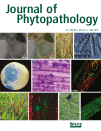View Item
- xmlui.general.dspace_homeCentros e Institutos de InvestigaciónCIAP. Centro de Investigaciones AgropecuariasInstituto de Patología VegetalArtículos científicosxmlui.ArtifactBrowser.ItemViewer.trail
- DSpace Home
- Centros e Institutos de Investigación
- CIAP. Centro de Investigaciones Agropecuarias
- Instituto de Patología Vegetal
- Artículos científicos
- View Item
Use of 454-Pyrosequencing for the characterization of Sweet potato virus C and Sweet Potato Feathery Mottle virus Isolates fron Argentina and Development of a Multiplex one - step RT-PCR for Their Simultaneous Detection
Abstract
454-pyrosequencing was applied as a tool to identify etiological agents involved in the symptoms observed in a sweet potato sample from Argentina. RNA was purified from symptomatic material and sequenced using a Roche 454 GS-FLX+. BLAST analysis of the viral reads identified the presence of Sweet potato feathery mottle virus (SPFMV)-O and SPFMV-RC strains and Sweet potato virus C (SPVC). For SPFMV-O and SPFMV–RC, 10 878 and 10 812 nucleotides,
[ver mas...]
454-pyrosequencing was applied as a tool to identify etiological agents involved in the symptoms observed in a sweet potato sample from Argentina. RNA was purified from symptomatic material and sequenced using a Roche 454 GS-FLX+. BLAST analysis of the viral reads identified the presence of Sweet potato feathery mottle virus (SPFMV)-O and SPFMV-RC strains and Sweet potato virus C (SPVC). For SPFMV-O and SPFMV–RC, 10 878 and 10 812 nucleotides, respectively, were sequenced, whereas a sequence of 10 793 nucleotides was obtained for SPVC. Pairwise comparison of polyprotein nucleotide sequences of O and RC Argentinian isolates (Arg) showed 99% and 98.4% sequence identities with SPFMV-O and SPFMV-RC-M2-41, respectively, whereas SPVC-Arg showed 94.2%, 92.9% and 94.6% sequence identities with SPVC-Il, SPVC-C1 and SPVC-Bungo, respectively. These results allowed us to develop a one-step multiplex reverse transcription-polymerase chain reaction assay (mRT-PCR) for the simultaneous detection and differentiation of SPFMV-O-Arg and SPFMV-RC-Arg and SPVC-Arg. Three specific forward primers unique to each virus and one reverse primer based on a region conserved in all three viruses were designed and used in the assay. These primers were further evaluated using field samples collected from four provinces of Argentina. The results showed that SPVC was the most common virus in samples analysed. This study shows the usefulness of deep sequencing not only to rapidly identify mixed infections between SPFMV-O and SPFMV-RC and SPVC, but also to develop a reliable mRT-PCR assay for detection of these sweet potato pathogens, which cannot be discriminated by serological techniques.
[Cerrar]

Fuente
Journal of phytophatology 164 (6) : 386–394. (June 2016)
Date
2016
ISSN
1439-0434 (Online)
Formato
pdf
Tipo de documento
artículo
Palabras Claves
Derechos de acceso
Restringido
 Excepto donde se diga explicitamente, este item se publica bajo la siguiente descripción: Creative Commons Attribution-NonCommercial-ShareAlike 2.5 Unported (CC BY-NC-SA 2.5)
Excepto donde se diga explicitamente, este item se publica bajo la siguiente descripción: Creative Commons Attribution-NonCommercial-ShareAlike 2.5 Unported (CC BY-NC-SA 2.5)

